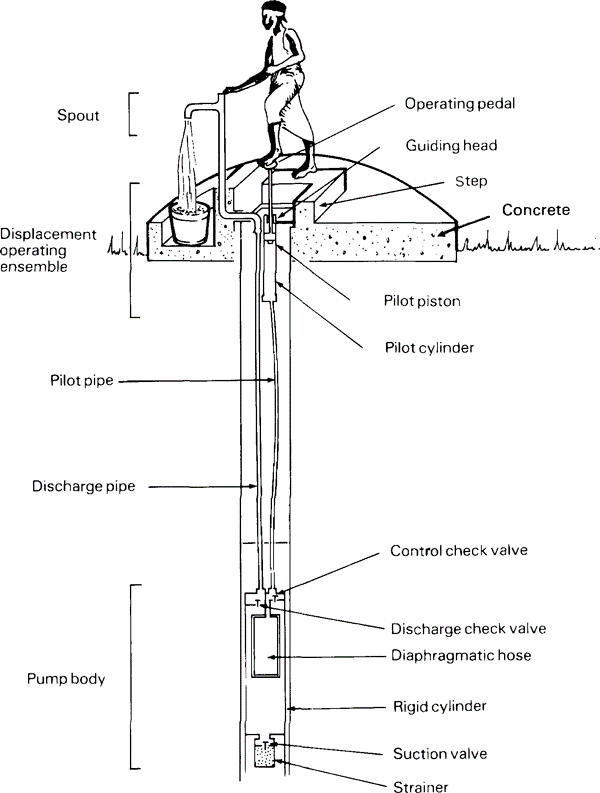WATER PUMP foot-operated (Vergnet) + accessories, set
Valid Article
WATER PUMP foot-operated (Vergnet)
Definition
Foot operated water pump designed for heavy-duty use in a community of ~ 300 people.
The pump raises a column of water through a delivery pipe up to the surface.
Designed to lift water from wells up to 10 - 50 metre.
To be used for clinics, health posts and communities.
Specifications
Diaphragm pump
The water is raised by the expansion of an elastic membrane. The displacement of the piston located at ground level is hydraulically transmitted to a rubber diaphragm in a stainless steel cylinder. The expansion and the contraction of the diaphragm delivers the water to the surface. The top cylinder is connected to the pumping element at the bottom, via a flexible hose. The pumping element is made of rubber and stainless steel, which makes this pump corrosion resistant.
Technical specifications
- Approximate discharge at about 75 watt input:
- at 10 metre head: 1.0 m3/h
- at 15 metre head: 0.9 m3/h
- at 20 metre head: 0.75 m3/h
- at 30 metre head: 0.65 m3/h
- conform VLMO (village level operation and maintenance) criteria
- light weight: 60 kg at 40 metre depth
- easy to instal: the use of polyethylene pipes enables it to be inserted in or extracted from the well by one or two people in less than 30 minutes, without specific handling equipment
- some of the pump parts can be made easily locally, contributing to local activity
- all wearing parts are at ground level and very accessible for replacement using a single tool delivered with the pump
- its technology enables the pump to feed a raised water tower.
- corrosion resistant thanks to the use of rust-proof materials
Instructions for use
Before installing:
- before the pump is installed, the borehole should be cleaned, disinfected and protected
- the water used for priming must be free of contamination
- pumping sand will damage the pump and should be avoided
- to ensure proper installation and operation of the pump, proceed according to the instructions provided by the manufacturer
- For more information, refer to "Community Water Supply: The Handpump Option", UNDP & World Bank
- See for more information:"SKAT water lifting", Baumann: page 75
Maintenance:
- maintenance is key and must be considered into the planning
- monthly and tri-monthly checks combined with yearly replacements significantly extend the life of the pump
- a lifting tackle and toolkit is needed for maintenance and repair
- it is essential to train pump mechanics and provide them with suitable tools
Main criteria to choose hand pumps:
- availability of pumps and spare parts; try to use models available in the region
- pump's type of use, i.e. use in family, small community, village, clinic...
- the depth of the well or borehole (an increasing length of the water column requires more effort to draw water as water is heavy)
- delivery head
- desired discharge rate
- quality of water (turbidity, corrosive matter...)
- price range of pump and spare parts
- ease of maintenance routine (are any special tools required, access to maintenance, e.g. replacing seals)
- ask your technical referent if you have any doubt in choosing and/or operating hand pumps

